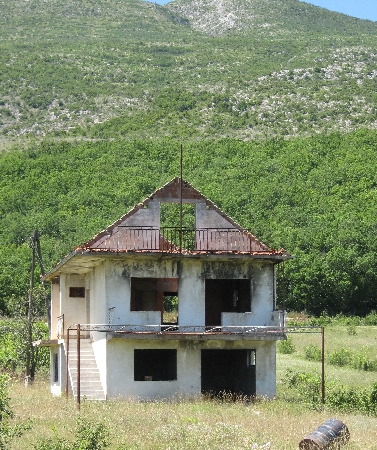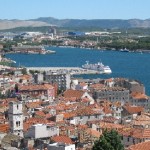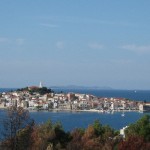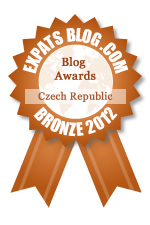
Sign warning of landmines by the road side between Šibenik & Knin © Ricky Yates
After spending the nights of Saturday 18th and Sunday 19th July in Primošten and exploring Šibenik, we set out on the morning of Monday 20th July on the long journey back to Prague. Having driven down into Croatia on the coast road, we decided to return through the interior. Therefore, once we had reached the outskirts of Šibenik, we headed inland on the road leading to Knin.
From background reading, I knew that we would be travelling through an area that was fought over during the conflict that took place between 1991 and 1995. So I was expecting that we would almost certainly see some remaining war damage. However, what we did observe still did come as quite a shock.
Within 20 km of the coast we saw the first few damaged buildings. Shortly afterwards we began to see signs like that in the adjacent photograph, warning people not to stray from the road onto the adjoining land because of the danger of the presence of unexploded landmines. Again, I’d read the advice on the Foreign and Commonwealth website warning British visitors to Croatia of this danger but it was still quite disturbing to see the signs in person.
In one sense I should not have been so surprised to see all this so near to the Dalmatian coast bearing in mind what I have written previously in this blog about Zadar being under siege for three months at the height of the war. Likewise, the guide I purchased to Šibenik Cathedral stated that the dome of the Cathedral had suffered war damage which has thankfully since been repaired.

War damaged bar-restaurant © Ricky Yates

Shrapnel and bullet damage © Ricky Yates
One particular building seemed to encapsulate what happened during the conflict and the situation that exists now. We saw this building as we drove by and stopped to investigate. It would appear to have been a bar-restaurant with accommodation for the owner on the upper floor. But it was completely burnt out with shrapnel and bullet damage still clearly visible.
This area around Knin is known as Krajina and, before the conflicts of the 1990s, it had a majority Serb population although lying within the boundaries of Croatia. When the nationalist government of Franjo Tudman declared Croatian independence in June 1991, the Serbian enclave of Krajina proclaimed its own independence from Croatia with the idea that it would become part of a ‘Greater Serbia’. Ethnic cleansing followed with the Croatian minority resident in the area being reduced from 44,000 to 900 in the following months.
However, when the Croatian army retook the area in 1995, driving out the Serb militia forces, up to 150,000 members of the Serb population also fled with the militia. The looting and burning that followed was no doubt designed to discourage their return.
The Dayton Accords signed in December 1995, which brought an end to the conflicts in the former Yugoslavia, recognised the traditional borders of Croatia but provided for the return of Serbian refugees and the restitution of their property. Whilst good in theory, the reality on the ground is very different. I suspect this property belongs to a Serb who has decided not to return. Hence it is ‘Na prodaju/For sale’ with a mobile telephone number. The owner is either fearful to return and/or can see no future for his former business in an independent Croatia.

War damaged house near Knin © Ricky Yates
Here is another photograph of a burnt out house. Whilst now peaceful, this area is littered with damaged buildings similar to these. Clearly the total population is now only half what it was before 1991.
I’ve deliberately referred to what happened between 1991 and 1995 as ‘the war’ or ‘the conflict’, trying to adopt the role of the neutral observer. But I couldn’t help but notice the language used in tourist material and published guides. Much tourist material makes no mention of ‘the war’ at all. After all, they don’t want to put off visitors! But when reference is made, it is called ‘the patriotic war’ (guide to Šibenik Cathedral) or ‘the homeland war’ (tourist literature about Karlovac – see my next post). Once I saw it referred to in slightly less jingoistic terms as ‘the Croatian War of Independence’. But all of these descriptions inevitably imply that the Croats were the ‘goodies’ and the Serbs were the ‘baddies’. The reality, as I’ve briefly described, is that atrocities were carried out on both sides and that much still needs to be done in the coming years to try and make some amends, resettle people and allow those that want to, to return to their former properties.

Moutainous scenery west of Knin © Ricky Yates
On reaching Knin, we headed northwest on a good road that runs through a wild and beautiful mountainous area roughly parallel to the Croatia/Bosnia border. I hope this picture on the left gives some indication of the attractiveness of the landscape. Eventually we reached the small town of Gracac where we managed to procure a late lunch in a pizza restaurant.

House being re-built in Gracac with prominent Croatian flag © Ricky Yates
Sitting on the balcony on the first floor of the restaurant building, we could see across the road to a small group of houses of which two or three were being repaired/re-built. Out of the roof of one of them was a flag pole with a large Croatian flag attached. Clearly the owner of this property wanted to make a very public statement as to his ethnicity. Whatever the nationality of any past owner, he was a Croat repairing/re-building his house within the independent Republic of Croatia!






it’s sad whenever they are wars for the purpose of so called ethnic cleansing…
too many needless death and pain…
someone shared in a blog that it was the Catholics who started it all leading to a spiralling tit-for-tat atrocities…
sometimes religion can’t really reach the monster within each of us humans…
anyway thanks for sharing!
peace!
Hi Geotacs,
As in so many conflicts, one can’t necessarily say who started it. But if you now read my following post, you will note my own view that both the Catholic & Orthodox Churches have sadly allowed themselves to be far too closely associated with the ardent nationalism which was the source of the atrocities to which you refer.
My apologies for being so slow to respond – I wanted to write the next post first of all!!